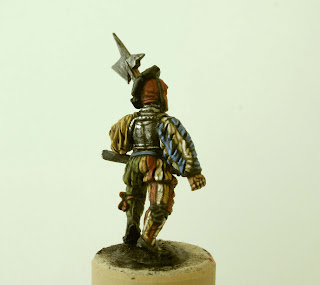As well as their flamboyant dress it's the little details that can really add the finishing touches to your figures.
1. Short sword (Katzbalger); take the time to paint the handle as metal and it will help to bring some focus to this key aspect of Landsknecht identity. You could also paint the top of the handle and alternate quillons (the 'S' bit) in gold. I usually paint the scabbard black and highlight at the edges to try and represent the dimple that the fuller of the blade would leave.

4. Coat linings; sometimes you can see an open tunic or jacket. These were invariably lined with a canvas / calico type material so paint it an off white or cream.
5. Sword belts; sometimes these were leather but often they were tied silk in a variety of colours.
6. Stripes; these were very common and they can be intimidating if you're a newcomer to them, paint them in the flow of the fabric and stance of the figure, also, as with the left leg of the arquebusier below, don't be tempted to have a stripe follow a sculpted slash as it can lead to them being uneven. Paint them evenly on the figure as you find it unless it is easy to follow a slash, here's a contemporary woodcut to help demonstrate this;
Another worthy detail to note from this woodcut is the tricolour stripe, try it with a few, it will add more interest and variety among your troops, here's an example;
Note also in this example that I have twisted the stripe slightly as it moves down the leg.
7. St Andrews Cross of the Empire; This is, more often than not, represented as two simple pieces of cloth on the front, back and occasionally arms of soldiers though with officers I have noticed a more elaborate ragged representation being depicted on the front of their coats. I also paint this on breastplates which looks good.
8. Peacock feathers; this was another symbol of the Empire, this basic example will help you get the colour and pattern right;
1. Short sword (Katzbalger); take the time to paint the handle as metal and it will help to bring some focus to this key aspect of Landsknecht identity. You could also paint the top of the handle and alternate quillons (the 'S' bit) in gold. I usually paint the scabbard black and highlight at the edges to try and represent the dimple that the fuller of the blade would leave.

2. Arming coif, also known as a 'schlappe', I tend to paint these in a variety of browns or off whites to represent the leather or canvas materials that these tended to be made of. Some coloured woodcuts also show these as red or green as in the example above.
3. Hats; These are depicted in a variety of colours and are occasionally patterned. Don't get too tempted to paint the hat strap in the same colour as the hat, try red, blue or green and it will add an extra element to your figure.4. Coat linings; sometimes you can see an open tunic or jacket. These were invariably lined with a canvas / calico type material so paint it an off white or cream.
5. Sword belts; sometimes these were leather but often they were tied silk in a variety of colours.
6. Stripes; these were very common and they can be intimidating if you're a newcomer to them, paint them in the flow of the fabric and stance of the figure, also, as with the left leg of the arquebusier below, don't be tempted to have a stripe follow a sculpted slash as it can lead to them being uneven. Paint them evenly on the figure as you find it unless it is easy to follow a slash, here's a contemporary woodcut to help demonstrate this;
7. St Andrews Cross of the Empire; This is, more often than not, represented as two simple pieces of cloth on the front, back and occasionally arms of soldiers though with officers I have noticed a more elaborate ragged representation being depicted on the front of their coats. I also paint this on breastplates which looks good.
8. Peacock feathers; this was another symbol of the Empire, this basic example will help you get the colour and pattern right;






Spectacular fuggireste!!!!!
ReplyDeletesorry, spectacular figures!!!!
ReplyDelete